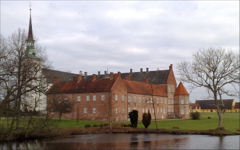
Brahetrolleborg
Encyclopedia

FYN
Proto-oncogene tyrosine-protein kinase Fyn is an enzyme that in humans is encoded by the FYN gene.This gene is a member of the protein-tyrosine kinase oncogene family. It encodes a membrane-associated tyrosine kinase that has been implicated in the control of cell growth...
, near the present Korinth. Before the Reformation
Reformation in Denmark
The Reformation in Denmark–Norway and Holstein was the transition from Roman Catholicism to Lutheranism in the realms ruled by the Copenhagen-based House of Oldenburg in the first half of the sixteenth century...
it was Holme Abbey , a Cistercian monastery.
Holme Abbey
The abbey was founded and settled in 1172 from the Cistercian Herrevad AbbeyHerrevad Abbey
Herrevad Abbey was a Cistercian monastery near Ljungbyhed in Klippan Municipality, Scania, in the south of present-day Sweden, but formerly in Denmark until 1658. It is now a country house known as Herrevad Castle .- History :...
in Scania
Scania
Scania is the southernmost of the 25 traditional non-administrative provinces of Sweden, constituting a peninsula on the southern tip of the Scandinavian peninsula, and some adjacent islands. The modern administrative subdivision Skåne County is almost, but not totally, congruent with the...
, now in Sweden
Sweden
Sweden , officially the Kingdom of Sweden , is a Nordic country on the Scandinavian Peninsula in Northern Europe. Sweden borders with Norway and Finland and is connected to Denmark by a bridge-tunnel across the Öresund....
, of which it was a daughter house. It was secularised during the Reformation
Reformation in Denmark
The Reformation in Denmark–Norway and Holstein was the transition from Roman Catholicism to Lutheranism in the realms ruled by the Copenhagen-based House of Oldenburg in the first half of the sixteenth century...
, probably in 1536.
Brahetrolleborg

Heinrich Rantzau
Heinrich Rantzau or Ranzow was a German humanist writer and statesman, a prolific astrologer and an associate of Tycho Brahe. He was son of Johan Rantzau....
, from whom it acquired for a time the name Rantzausholm. After reverting again to the Crown in 1661, it was granted in 1664 by King Frederick III of Denmark
Frederick III of Denmark
Frederick III was king of Denmark and Norway from 1648 until his death. He instituted absolute monarchy in Denmark and Norway in 1660, confirmed by law in 1665 as the first in western historiography. He was born the second-eldest son of Christian IV of Denmark and Anne Catherine of Brandenburg...
to his court favourite, the German
Germans
The Germans are a Germanic ethnic group native to Central Europe. The English term Germans has referred to the German-speaking population of the Holy Roman Empire since the Late Middle Ages....
merchant and politician Christoffer Gabel, who exchanged it three years later for the chalk mountain of Segeberg
Bad Segeberg
Bad Segeberg is a German town of 16,000 inhabitants, located in the state of Schleswig-Holstein, capital of the district Segeberg. It is situated approximately northeast of Hamburg, and west of Lübeck.It is famous for its annual Karl-May-Festival...
with Birgitte Nielsdatter, of the Trolle family and married into the Brahe family, whence the name of the castle and also of her barony, Brahetrolleborg. The Trolles sold it in 1722 to Christian Detlev von Reventlow, the Oberpräsident of Altona
Altona, Hamburg
Altona is the westernmost urban borough of the German city state of Hamburg, on the right bank of the Elbe river. From 1640 to 1864 Altona was under the administration of the Danish monarchy. Altona was an independent city until 1937...
, and the estate has remained until today in the Reventlow
Reventlow
The name Reventlow, a noble Danish surname, may refer to:* Anne Sophie Reventlow, queen consort of Denmark * Christian Detlev Reventlow Danish diplomat and military leader 1671-1738)...
family.
Buildings
The former Cistercian church, laid out according to the plan of Saint BernardBernard of Clairvaux
Bernard of Clairvaux, O.Cist was a French abbot and the primary builder of the reforming Cistercian order.After the death of his mother, Bernard sought admission into the Cistercian order. Three years later, he was sent to found a new abbey at an isolated clearing in a glen known as the Val...
, is now the chapel of Brahetrolleborg. It has a tower on the west front, and possesses a crucifix by Claus Berg of about 1500. The conventual buildings, located to the right of the church, were converted after secularisation for use as a castle, which was comprehensively overhauled in about 1870.

